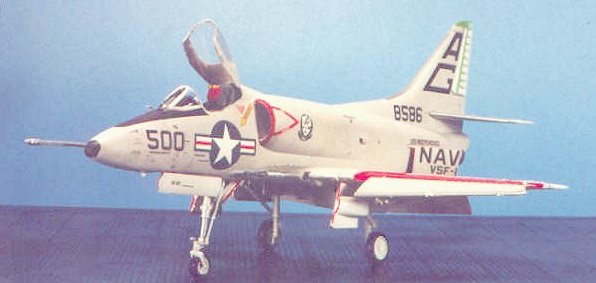
Hasegawa 1/48 A-4C Skyhawk
|
KIT # |
7222 |
|
PRICE: |
$29.95 |
|
DECALS: |
Two aircraft |
|
REVIEW : |
|
|
NOTES: |
Superscale 48-728 decal sheet used |

|
HISTORY |
The Skyhawk, along with the A-20 "Havoc," SBD "Dauntless," B-26 "Invader," AD "Skyraider," F4D "Skyray" and F5D "Skylancer," and A3D "Skywarrior," is the product of one of the few true geniuses of aviation: Ed Heinemann. Heinemann began his career in the 1930s, working for the visionary Jack K. Northrop, for whom he created the BT-1 dive bomber; when Northrop's company was absorbed by Douglas Aircraft and became the Douglas El Segundo Division, the best thing Donald Douglas acquired was Northrop's young designer. The BT-1 went on to become the SBD "Dauntless."
By the early 1950s, Heinemann, along with every other aircraft designer, was dismayed by the growth in weight and technical complexity that jet power had brought to aviation. Where other designers might chafe at this and then create an airframe that could carry the weight, Heinemann fought it. When the Bureau of Aeronautics started looking for a jet-powered replacement of the Able-Dog "Skyraider," they expected an airplane about the size of today's A-10. What they got from Heinemann was a proposal for an airplane so small that it wouldn't need folding wings to fit on a standard carrier elevator and would hold the record as the smallest operational aircraft in its class ever used by the Navy. The airplane was to be used in day attack, capable of divebombing, interdiction and close support missions; when the requirement of carrying a (then heavy) nuclear weapon was added to the specification, Heinemann's answer was "no problem."
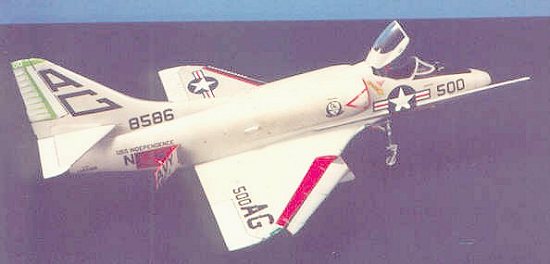 The result of the design
that began in 1952 with a proposal for a light fighter was the A4D "Skyhawk,"
the first of the long-life jets, an airplane that first flew on June 22, 1954,
and entered service with the U.S. Navy in 1956, that as of today has yet to
leave first-line service in the Singapore air force and the Argentine air
forces, having only recently stood down with the RNZAF, after service with the
USN, USMC, Royal Australian Navy, and Israeli air forces, most of that service
involving combat.
The result of the design
that began in 1952 with a proposal for a light fighter was the A4D "Skyhawk,"
the first of the long-life jets, an airplane that first flew on June 22, 1954,
and entered service with the U.S. Navy in 1956, that as of today has yet to
leave first-line service in the Singapore air force and the Argentine air
forces, having only recently stood down with the RNZAF, after service with the
USN, USMC, Royal Australian Navy, and Israeli air forces, most of that service
involving combat.
The A4D-2N - the third version of the Skyhawk to enter service - featured limited all-weather capability, with the addition of an APG-53 terrain-clearance radar, the AJB-3 all-attitude reference and loft-bombing system, a TPQ-10 ground control blind bombing system, angle-of-attack indicator, an improved gunsight and an automatic flight control system. First flight of the AD4-2N was August 21, 1958, with introduction into service commencing in March 1960 with VMA-225 at MCAS Cherry Point. This was the first Skyhawk produced in substantial numbers, with a total production run of 638. The A4D-2N was powered - as were the A4D-1 and A4D-2 - by the Wright J-65, a license-built version of the Armstrong-Siddeley Sapphire.
The A4D-2N - by then redesignated the A-4C under the new tri-service designation system - first faced the possibility of going to war in the Cuban Missile Crisis of October, 1962. Two years later, the A-4C would go to war, with its participation in the "Tonkin Gulf Strikes," the American response to alleged "unprovoked attacks" by North Vietnamese torpedo boats on two U.S. Navy Destroyers, the "Maddox" and the "Turner Joy." (Yours Truly, as a member of the Staff of Commander, Patrol Forces, Seventh Fleet, had - since April 1964 - been writing up operation orders from ComPacFlt for a strike against North Vietnamese ports "upon suitable provocation." According to the Chief Sonarman on the "Maddox", there never were any "unprovoked attacks" on the two destroyers, which were firing on Hon Me island in support of South Vietnamese commando raids on North Vietnamese territory. The closest either ship came to danger was when the C.O. of the "Maddox" ordered "open fire" the second night of the "incident," to which the FT3 in the fire control tower responded, "Sir, the only target is the Turner Joy" - he was relieved of duty and reduced to FTSN in a court-martial for "failure to obey a direct order.")
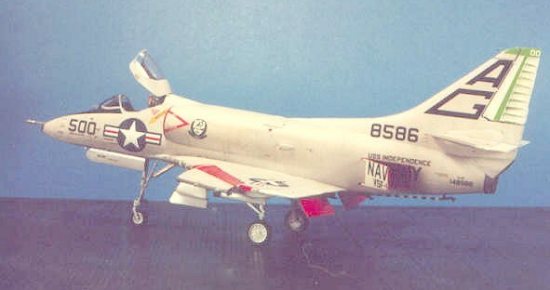 After the A-4E with
the uprated J-57 engine and increased load-carrying capacity began to replace
the A-4C in 1965, the A-4C carried on with other units. Among them were two VSF
squadrons - so designated because they provided a "fighter" capability to the
anti-submarine CVS carriers, which were otherwise equipped with S-2 "Tracker"
anti-submarine aircraft. VSF-1, the Atlantic Fleet squadron, provided 4-plane
detachments that went aboard the deploying CVS units, during 1967-69, while
VSF-2 provided a similar capability for the Pacific Fleet in 1968-69. When the
dedicated anti-submarine carriers were pulled off the line in 1969, the VSF
units were disbanded.
After the A-4E with
the uprated J-57 engine and increased load-carrying capacity began to replace
the A-4C in 1965, the A-4C carried on with other units. Among them were two VSF
squadrons - so designated because they provided a "fighter" capability to the
anti-submarine CVS carriers, which were otherwise equipped with S-2 "Tracker"
anti-submarine aircraft. VSF-1, the Atlantic Fleet squadron, provided 4-plane
detachments that went aboard the deploying CVS units, during 1967-69, while
VSF-2 provided a similar capability for the Pacific Fleet in 1968-69. When the
dedicated anti-submarine carriers were pulled off the line in 1969, the VSF
units were disbanded.
The A-4C continued in service with Naval Reserve units into the mid-1970s. Equipped with the same avionics pack as the A-4F and updated A-4E aircraft, it was designated A-4L.
The A-4Cs were provided to the Argentine Navy after they left front line Navy service in the late 1960s, and saw combat in the Falklands war where their air-to-air refueling ability gave them the range to fly out from the Argentine mainland to the area east of the Falklands where the Royal Navy task force was operating. By that time, the A-4Cs were more than 20 years old, yet they still provided good service and their record against a better-equipped enemy is one that maintains the Skyhawk's sterling reputation.
|
THE KIT |
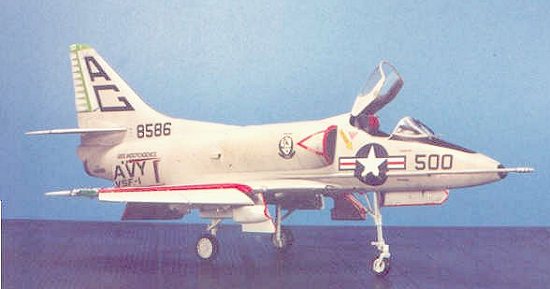 The A-4C differs from
the earlier release of the A-4E with a shorter fuselage nose, and different
engine intakes. Due to this, the fuselage mold is different from that in the
first release.
The A-4C differs from
the earlier release of the A-4E with a shorter fuselage nose, and different
engine intakes. Due to this, the fuselage mold is different from that in the
first release.
Decals include an airplane of VA-153, the "Blue Tails," aboard U.S.S. "Ticonderoga" during the Vietnam war, and an aircraft assigned to the U.S.S. Forrestal.
Several aftermarket sheets have already been released, including several sheets of A-4C and A-4L aircraft from Eagle Strike and two (Now four. Ed) sheets of A-4Cs from Super Scale. I chose to use the sheet from SuperScale that had the markings for an A-4C of VSF-1 assigned to U.S.S. "Independence" during a Mediterranean cruise in 1966.
|
CONSTRUCTION |
What can I say? The kit goes together as did the A-4E, other than the intakes are different. The design and fit of the kit is excellent, and any modeler who follows the instructions will find no difficulty. I only used Mr. Surfacer on the centerline seam of the fuselage.
|
PAINT & DECALS |
Painting:
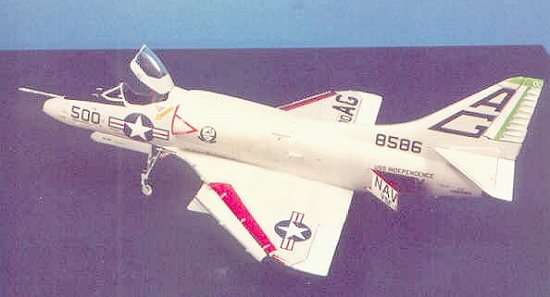 I painted the red
areas that involve the leading edge slats, flap interiors and dive brake
interiors first. I masked those off and "pre-shadowed the model with dark grey
- I chose this since I was going to paint it white and light grey, and did not
want to have to apply the additional paint to cover flat black pre-shading, to
obtain the same result.
I painted the red
areas that involve the leading edge slats, flap interiors and dive brake
interiors first. I masked those off and "pre-shadowed the model with dark grey
- I chose this since I was going to paint it white and light grey, and did not
want to have to apply the additional paint to cover flat black pre-shading, to
obtain the same result.
The model was painted with Gunze-Sanyo H-316 "White FS17875" and H-315 "Gray FS16440". While that was drying, I hand-painted the red borders of the landing gear. When all was dry, I gave the model a good coat of Future.
Decals:
I used the Hasegawa kit decals for the national markings, since they included a starboard-side fuselage insignia that was shaped to go over the refueling boom and provide the correct shape for the marking. I also used the kit decals for the stenciling. I used the SuperScale decals for the unit markings. Everything went on easily; after applying Micro-Sol, I hit the Hasegawa decals with a final volley of "heavy artillery" in the form of a coat of Solvaset, and everything went down fine. I also used some aluminum stripe decals from the decal dungeon for the leading edges of the wings and stabilizers.
Final finish:
I gave the model a final coat of Future, then painted the upper surfaces with a coat of thinned Dullcote, leaving the white areas gloss. I attached the landing gear and open canopy, and the model was finished.
|
CONCLUSIONS |
Out of the box, this is an excellent model. Those "Scooter nuts" among you can dress up the cockpit with Cutting Edge seat (which definitely looks better than the kit seat), and use ordnance from the Hasegawa ordnance set to make your "Bantam Bomber" look like one.
Copyright ModelingMadness.com
If you would like your product reviewed fairly and fairly quickly, please contact the editor or see other details in the Note to Contributors.